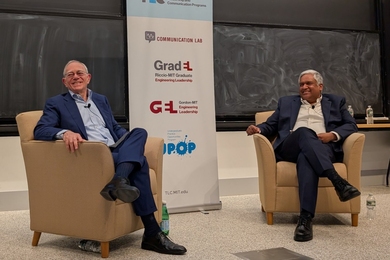George M.C. Fisher, an engineer and mathematician who has led two Fortune 200 firms, described his first actions as Eastman Kodak's chairman, president and CEO at the April 28 Leaders in Technology and Management Lecture: he eliminated more than a third of the $22 billion company's enterprises.
By selling Eastman Kodak's pharmaceutical and over-the-counter drug businesses in 1993-94, Dr. Fisher refocused the company on its roots: making pictures. This drastic decision was essential, he said. "If you don't have the resources to implement a strategy, then you don't have a strategy -- and we didn't." Refocusing the company on making pictures, rather than film and chemical processing, allowed the company to build itself into the digital future rather than be eliminated by it. "Today we are a smaller company but our returns are higher. We have a 12 percent after-tax profit," he said.
"What matters is that the business is growing; growth is the ultimate measure of customer satisfaction," said Dr. Fisher, adding that Eastman Kodak is heading toward double-digit growth from near zero when he became CEO. Not only has US market share increased, but a new push in emerging markets has rendered results, such as moving China up from the company's 17th-largest market to its third-largest.
Another major growth opportunity is digital technology, Dr. Fisher said. As digital image-making became popular, many at Eastman Kodak felt threatened, but he took a different view. "Digital technology is the biggest enabler of growth and the Internet is becoming the primary vehicle for services," he said. He identified four strategic areas to watch:
��������� Marketing -- the Internet has revolutionized marketing by allowing companies direct contact with customers.
��������� Watch out for Wal-Mart -- old-economy giants will be formidable when they get fully trained on Internet opportunities.
��������� New value propositions -- new-economy businesses often give away what old-economy companies produce, so traditional companies must create their own new value propositions.
��������� New market values -- dotcom values are not based on traditional earnings/share ratios but on the capacity to create future customers, and they may be priced right.
RELATIONSHIP WITH MIT
Even at the Internet speed of today's economy, he noted, some traditional business concepts such as valuing customers and employees still count -- as does the historic relationship between Eastman Kodak and MIT. The company today supports many MIT initiatives, including Leaders for Manufacturing and the Media Lab. That support started early. In the late 1880s, MIT alumnus and Eastman Kodak employee Frank Lovejoy interested company founder George Eastman in contributing to MIT, a relationship that generated major gifts early this century.
Before joining Eastman Kodak, Dr. Fisher was CEO and chairman of Motorola, Inc., a member company of the Center for Technology, Policy and Industrial Development (CTPID) Internet and Telecoms Convergence Consortium. He is an elected member of the American Academy of Arts and Sciences and the National Academy of Engineering, which he will chair as of July 1.
The Leaders in Technology and Management Lecture series is co-sponsored by the Office of Corporate Relations and CTPID.
A version of this article appeared in MIT Tech Talk on May 10, 2000.






